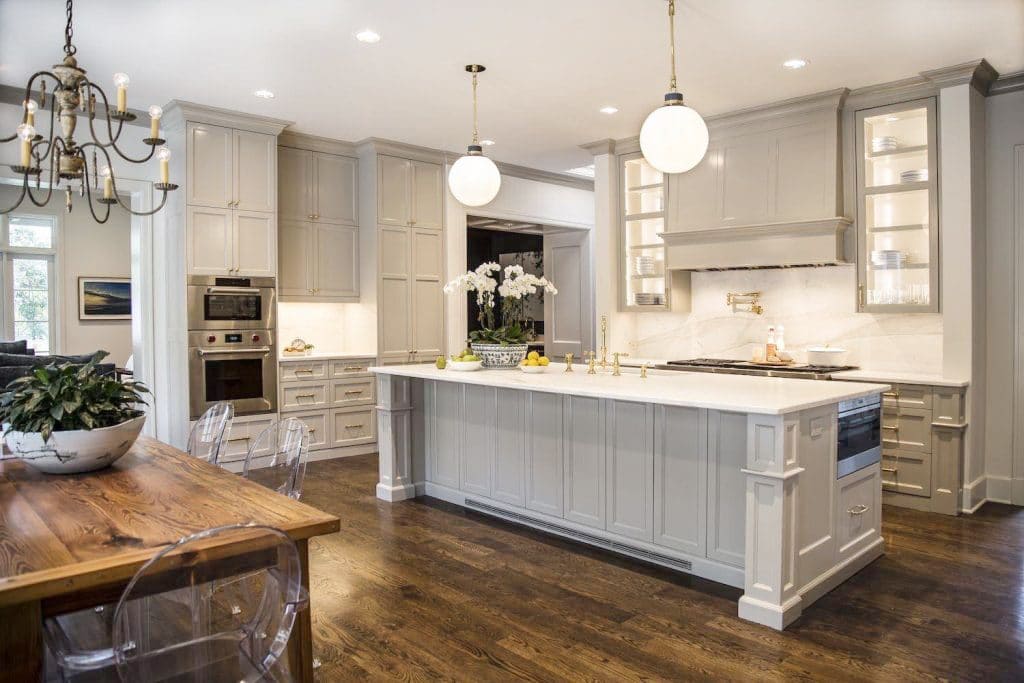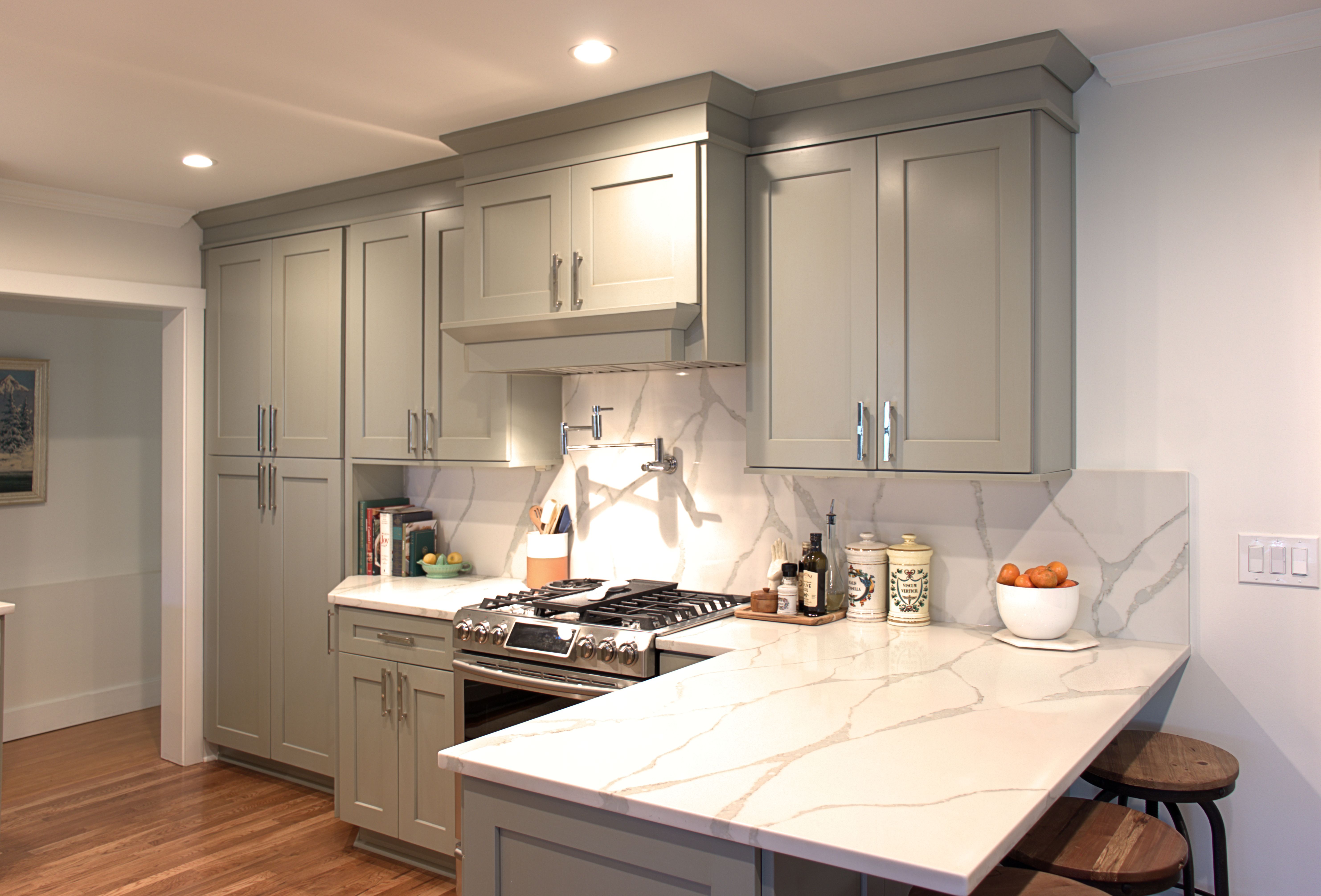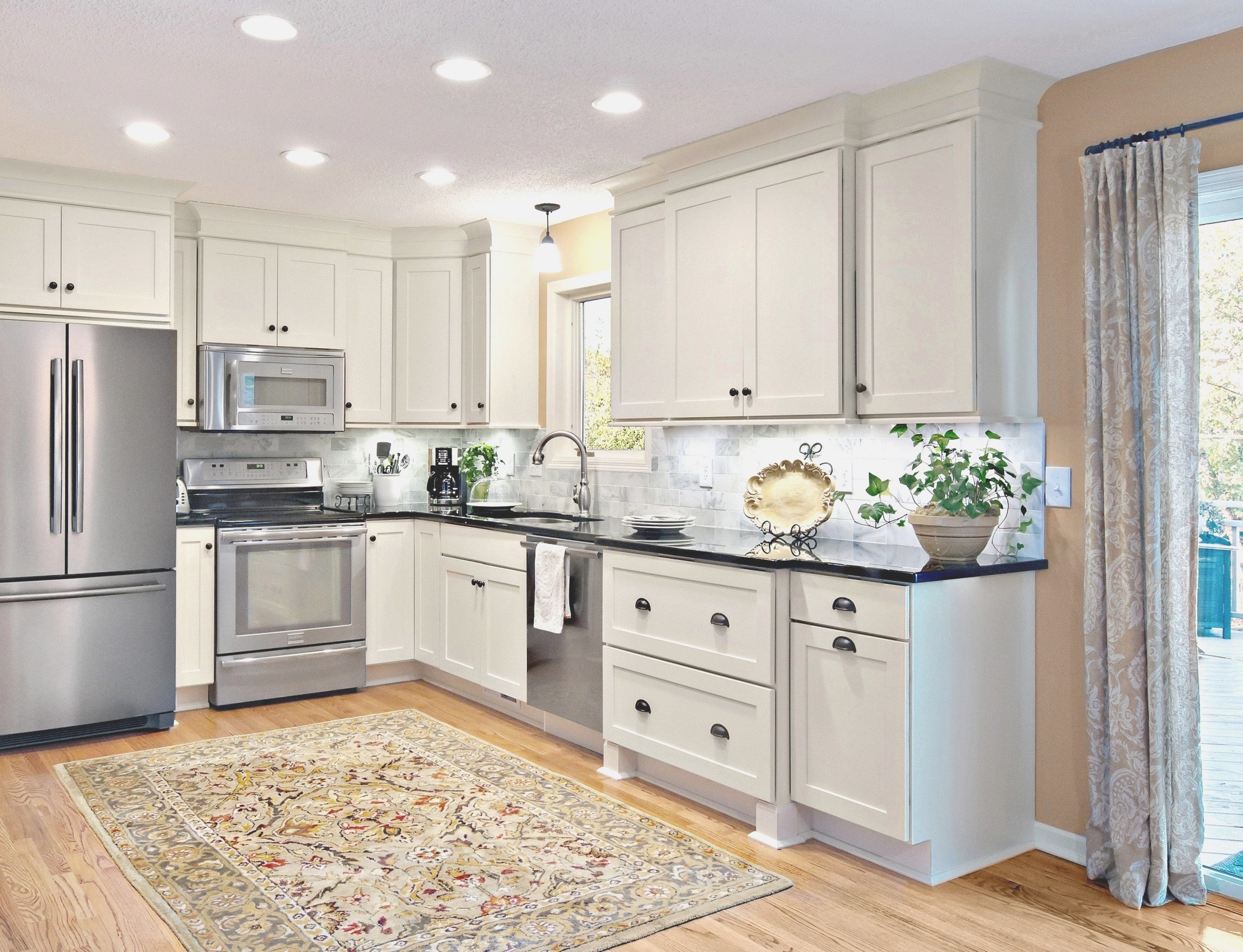Design Considerations

Crown molding, a decorative trim that adds a finishing touch to cabinets, can significantly impact the overall aesthetic of a kitchen. The color of the crown molding plays a crucial role in creating a harmonious and visually appealing design. By strategically choosing the right color, you can enhance the kitchen’s style, highlight the cabinets, and create a cohesive look.
Impact of Crown Molding Color on Kitchen Design Aesthetics
The color of the crown molding can influence the perception of the kitchen’s size, style, and overall ambiance. A darker crown molding can make the kitchen feel more intimate and cozy, while a lighter color can create a sense of spaciousness and airiness.
For instance, a dark crown molding paired with light-colored cabinets can create a dramatic and sophisticated look. Conversely, a white crown molding against dark cabinets can add a touch of brightness and contrast, highlighting the cabinets’ design.
Crown Molding Color Combinations
Crown molding color combinations can be chosen based on personal preference, existing kitchen decor, and desired aesthetic. Here are some popular combinations:
- Matching the Cabinets: A classic and timeless approach, matching the crown molding color to the cabinets creates a seamless and cohesive look. This option is particularly suitable for traditional kitchens with intricate cabinet details.
- Contrasting Colors: A bolder choice, contrasting the crown molding color with the cabinets adds visual interest and depth. This approach is ideal for modern kitchens with sleek and minimalist designs. For example, a black crown molding against white cabinets creates a striking and modern contrast.
- Complementary Colors: Selecting complementary colors, such as blue and orange or green and red, can create a vibrant and energetic atmosphere. This approach is best suited for kitchens with bold and colorful design elements.
- Neutral Colors: Neutral colors like white, gray, or beige are versatile and blend seamlessly with various cabinet colors and styles. This option is ideal for creating a clean and contemporary look.
Choosing a Crown Molding Color
When selecting a crown molding color, consider the following factors:
- Cabinet Style and Finishes: The crown molding color should complement the existing cabinet style and finishes. For example, a traditional kitchen with ornate cabinets may benefit from a darker crown molding, while a modern kitchen with sleek cabinets might look best with a lighter or contrasting color.
- Existing Decor: The crown molding color should harmonize with the existing kitchen decor, including wall colors, flooring, and countertop materials. Consider using a color that complements or contrasts with these elements to create a cohesive design.
- Lighting: The lighting in the kitchen can influence how the crown molding color appears. Natural light tends to make colors appear brighter, while artificial light can make them appear darker. Consider testing different color options under various lighting conditions to ensure the desired effect.
- Personal Preference: Ultimately, the best crown molding color is the one that you find visually appealing and complements your personal style. Experiment with different colors and combinations until you find the perfect match for your kitchen.
Installation and Techniques

Installing crown molding with different colored options adds a unique touch to your kitchen cabinets, enhancing their visual appeal and creating a statement piece. The process involves careful planning, precise measurements, and the use of appropriate tools and materials.
Tools and Materials for Crown Molding Installation
The tools and materials required for a successful crown molding installation vary depending on the complexity of the project and the chosen installation method. However, some essential tools and materials are common across different installations:
- Measuring tape: Accurately measuring the length of the crown molding and the cabinets is crucial for precise cutting and fitting.
- Miter saw: This tool is used for making precise angled cuts, essential for creating mitered corners and ensuring a seamless finish.
- Nail gun: A nail gun is used to securely attach the crown molding to the cabinets. Choose a nail gun with appropriate power and nail size for the material of the crown molding and cabinets.
- Caulk gun: Caulk is used to fill gaps and seams between the crown molding and the cabinets, creating a smooth and finished look.
- Caulk: Select a caulk that is compatible with the materials used for the crown molding and cabinets. Consider using paintable caulk for a seamless finish.
- Wood filler: Wood filler is used to fill any gaps or holes in the crown molding or cabinets before painting.
- Sandpaper: Sandpaper is used to smooth out any rough edges or imperfections before painting.
- Primer: Primer is used to create a smooth surface for painting and helps the paint adhere better.
- Paint: Choose paint that is compatible with the materials used for the crown molding and cabinets. Consider using a high-quality paint for a durable and long-lasting finish.
- Paint brushes and rollers: Use brushes and rollers that are appropriate for the type of paint used.
- Safety glasses: Protect your eyes from flying debris when using power tools.
- Gloves: Protect your hands from splinters and paint.
- Level: A level is used to ensure the crown molding is installed straight and even.
- Pencil: Mark the cutting lines on the crown molding.
- Clamps: Clamps are used to hold the crown molding in place while attaching it to the cabinets.
Methods for Achieving a Clean and Seamless Finish
Achieving a clean and seamless finish for crown molding installation is crucial for a professional look. Different methods can be used to achieve this, each with its own advantages and disadvantages.
- Mitered Corners: This method involves making precise angled cuts on the crown molding, creating a seamless joint at the corners. This method requires careful measurements and precise cutting using a miter saw. While it offers a clean and elegant look, it can be challenging for beginners and requires more time and effort.
- Cope and Stick Method: This method involves creating a profile on one piece of crown molding that perfectly matches the profile of the adjacent piece. This allows for a seamless joint without the need for mitered cuts. This method is more time-consuming but offers a more forgiving and precise fit. It is ideal for intricate crown molding designs and requires specialized tools like a coping saw or a router.
- Using Pre-Mitered Crown Molding: This method uses pre-cut crown molding pieces that are already mitered at the corners. This simplifies the installation process, reducing the need for precise cutting and fitting. While it is a convenient option, it may not be available for all crown molding designs and can be more expensive.
Styles and Trends: Kitchen Cabinets With Different Colored Crown Molding

Crown molding in kitchens has evolved beyond purely decorative elements, becoming an integral part of the design scheme. It adds visual interest, defines spaces, and enhances the overall aesthetic appeal.
Crown Molding Styles and Their Suitability for Different Kitchen Cabinet Designs, Kitchen cabinets with different colored crown molding
Crown molding styles offer a range of visual effects, complementing various kitchen cabinet designs. The choice of crown molding style should harmonize with the overall design aesthetic, enhancing the kitchen’s ambiance.
| Crown Molding Style | Description | Suitable Kitchen Cabinet Designs |
|---|---|---|
| Simple Casing | A basic, understated style featuring a single, rectangular molding. | Modern, Minimalist, Contemporary |
| Ogee | A more ornate style with a curved profile, often featuring a concave and convex section. | Traditional, Transitional, Farmhouse |
| Dentil | A decorative molding featuring small, rectangular projections resembling teeth. | Classic, Traditional, Formal |
| Cove | A curved molding with a concave profile, creating a smooth transition between the ceiling and wall. | Modern, Contemporary, Minimalist |
| Beadboard | A molding featuring a series of vertical, raised panels, adding a rustic and cottage-style appeal. | Rustic, Farmhouse, Cottage |
Current Trends in Kitchen Cabinet and Crown Molding Color Combinations
Contemporary kitchen design trends prioritize color harmony and a cohesive aesthetic. Crown molding color choices often complement or contrast with the cabinet color, creating a visually appealing balance.
- White Cabinets with Dark Crown Molding: This combination creates a bold statement, adding visual interest and depth to the kitchen. Popular choices for dark crown molding include black, navy, or charcoal.
- Gray Cabinets with White Crown Molding: This classic combination offers a clean and modern aesthetic, allowing the cabinets to take center stage.
- Two-Tone Cabinets with Matching Crown Molding: Two-tone cabinets often feature a darker lower cabinet color and a lighter upper cabinet color. Matching the crown molding to the upper cabinet color creates a seamless transition.
- Matching Crown Molding to Cabinet Accents: For a cohesive look, consider matching the crown molding to cabinet hardware, backsplash tiles, or other accents.
Visual Guide: Crown Molding Colors and Their Influence on Kitchen Ambiance
Crown molding colors play a significant role in shaping the overall ambiance of a kitchen.
Dark Crown Molding: Darker crown molding colors, such as black, navy, or charcoal, add drama and sophistication, creating a more formal and elegant atmosphere.
Light Crown Molding: Light crown molding colors, such as white, cream, or beige, create a sense of spaciousness and brightness, enhancing the airy and inviting feel of the kitchen.
Bold Crown Molding Colors: Bold crown molding colors, such as vibrant blues, greens, or reds, can add a pop of personality and energy to the kitchen.
Kitchen cabinets with different colored crown molding – Adding a pop of color with a contrasting crown molding above your kitchen cabinets is a fun way to personalize your space. And if you’re looking for a fresh start in a new city, perhaps a charming one-bedroom apartment in Augusta, GA, could be your next move! Check out these affordable options to find the perfect spot for your kitchen cabinet makeover dreams.
Once you’re settled, you can start experimenting with different crown molding colors to find the perfect match for your style.
Imagine a kitchen with sleek, white cabinets topped with a bold, contrasting crown molding in a rich mahogany. It’s a touch of elegance that elevates the space, just like the luxurious feel of a Texas 5 bedroom house with its sprawling layout and stunning design.
And while you’re dreaming of that perfect Texas home, why not add a splash of personality to your kitchen with a playful pop of color in the crown molding? It’s a simple detail that can make a world of difference.